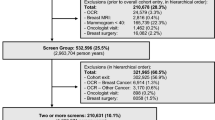Abstract
Purpose
We compare breast and colorectal cancer survivors’ annual receipt of preventive care and office visits to that of age- and gender-matched cancer-free controls.
Methods
Automated data, including tumor registries, were used to identify insured individuals aged 50+ at the time of breast or colorectal cancer diagnosis between 2000 and 2008 as well as cancer-free controls receiving care from four integrated delivery systems. Those with metastatic or un-staged disease, or a prior cancer diagnosis were excluded. Annual visits to primary care, oncology, and surgery as well as receipt of mammography, colorectal cancer, Papanicolaou, bone densitometry, and cholesterol screening were observed for 5 years. We used generalized estimating equations that accounted for repeated observations over time per person to test annual service use differences by cancer survivor/cancer-free control status and whether survivor/cancer-free status associations were moderated by patient age <65 years and calendar year of diagnosis.
Results
A total of 3743 breast and 1530 colorectal cancer survivors were identified, representing 12,923 and 5103 patient-years of follow-up, respectively. Compared to cancer-free controls, breast and colorectal cancer survivors were equally or more likely to use all types of office visits and to receive cancer screenings and bone densitometry testing. Both breast and colorectal cancer survivors were less likely than cancer-free controls to receive cholesterol testing, regardless of age, year of diagnosis, or use of primary care.
Implications for Cancer Survivors
Programs targeting cancer survivors may benefit from addressing a broad range of primary preventive care needs, including recommended cardiovascular disease screening.
Similar content being viewed by others
References
National, Cancer, and Institute. Survivorship-related statistics and graphs. 2013 [cited 2013 May 2, 2013]; Available from: http://dccps.nci.nih.gov/ocs/prevalence/.
Schonberg MA et al. Causes of death and relative survival of older women after a breast cancer diagnosis. J Clin Oncol. 2011;29(12):1570–7.
Mandel JS et al. Reducing mortality from colorectal cancer by screening for fecal occult blood. Minnesota Colon Cancer Control Study. N Engl J Med. 1993;328(19):1365–71.
Duffy CM, Clark MA, Allsworth JE. Health maintenance and screening in breast cancer survivors in the United States. Cancer Detect Prev. 2006;30(1):52–7.
Bellizzi KM et al. Health behaviors of cancer survivors: examining opportunities for cancer control intervention. J Clin Oncol. 2005;23(34):8884–93.
Trask PC et al. Cancer screening practices among cancer survivors. Am J Prev Med. 2005;28(4):351–6.
Findley PA, Sambamoorthi U. Preventive health services and lifestyle practices in cancer survivors: a population health investigation. J Cancer Surviv. 2009;3(1):43–58.
Yabroff KR, Machlin SPS, et al. Access to preventive health care for cancer survivors. Am J Prev Med. 2013;45(3):304–12.
Earle CC, Neville BA. Under use of necessary care among cancer survivors. Cancer. 2004;101(8):1712–9.
Earle CC et al. Quality of non-breast cancer health maintenance among elderly breast cancer survivors. J Clin Oncol. 2003;21(8):1447–51.
Snyder CF et al. Comparing care for breast cancer survivors to non-cancer controls: a five-year longitudinal study. J Gen Intern Med. 2009;24(4):469–74.
Snyder CF et al. Prevention, screening, and surveillance care for breast cancer survivors compared with controls: changes from 1998 to 2002. J Clin Oncol. 2009;27(7):1054–61.
The HMO SCR: Cancer Research Network. [cited 2013 May 5, 2013]; Available from: http://crn.cancer.gov/.
Cooper GS et al. The utility of administrative data for measuring adherence to cancer surveillance care guidelines. Med Care. 2007;45(1):66–72.
Elston Lafata J et al. Routine surveillance care after cancer treatment with curative intent. Med Care. 2005;43(6):592–9.
Lamont EB et al. Measuring disease-free survival and cancer relapse using Medicare claims from CALGB breast cancer trial participants (companion to 9344). J Natl Cancer Inst. 2006;98(18):1335–8.
U.S. Preventive Services Task Force. [cited 2013 May 6, 2013]; Available from: (http://www.uspreventiveservicestaskforce.org/).
Screening for osteoporosis: U.S. Preventive Services Task Force recommendation statement. Ann Intern Med, 2011. 154(5): p. 356–64.
Salloum RG et al. Adherence to surveillance care guidelines after breast and colorectal cancer treatment with curative intent. Cancer. 2012;118(22):5644–51.
Hornbrook MC et al. Building a virtual cancer research organization. J Natl Cancer Inst Monogr. 2005;35:12–25.
Klabunde CN et al. A refined comorbidity measurement algorithm for claims-based studies of breast, prostate, colorectal, and lung cancer patients. Ann Epidemiol. 2007;17(8):584–90.
US, Census, and Bureau. Small area income and poverty estimates. State and county estimates for 2000 [cited 2013 May 6, 2013]; Available from: http://www.census.gov/did/www/saipe/data/statecounty/data/2000.html.
Health insurance rankings: how does your plan compare? 2012 [cited 2013 6/13/2013]; Available from: http://www.consumerreports.org/cro/magazine/2012/11/health-insurance-rankings/index.htm.
Fishman PA et al. The challenge of conducting comparative effectiveness research in cancer: the impact of a fragmented U.S. health-care system. J Natl Cancer Inst Monogr. 2013;2013(46):99–105.
Fenton JJ et al. Influence of primary care use on population delivery of colorectal cancer screening. Cancer Epidemiol Biomarkers Prev. 2009;18(2):640–5.
Zimmerman RK et al. Predictors of colorectal cancer screening in diverse primary care practices. BMC Health Serv Res. 2006;6:116.
Shires DA et al. Colorectal cancer screening use among insured primary care patients. Am J Manage Care. 2011;17(7):480–8.
McCarthy BD et al. Screening mammography use: the importance of a population perspective. Am J Prev Med. 1996;12(2):91–5.
Snyder CF et al. Preventive care for colorectal cancer survivors: a 5-year longitudinal study. J Clin Oncol. 2008;26(7):1073–9.
Hudson SV et al. Adult cancer survivors discuss follow-up in primary care: ‘not what i want, but maybe what i need’. Ann Fam Med. 2012;10(5):418–27.
Institute of Medicine, N.R.C.o.t.N.A., From cancer patient to cancer survivor: lost in transition. 2006: Washington DC.
Conflict of interest
The authors have no conflicts of interest to report.
Author information
Authors and Affiliations
Corresponding author
Rights and permissions
About this article
Cite this article
Lafata, J.E., Salloum, R.G., Fishman, P.A. et al. Preventive care receipt and office visit use among breast and colorectal cancer survivors relative to age- and gender-matched cancer-free controls. J Cancer Surviv 9, 201–207 (2015). https://doi.org/10.1007/s11764-014-0401-3
Received:
Accepted:
Published:
Issue Date:
DOI: https://doi.org/10.1007/s11764-014-0401-3




